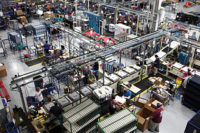There are two opposite ways to equip factories to respond quickly to downstream customer orders: One way is for sequential production, and the other is for concurrent production. Both draw heavily from best practices in lean manufacturing.
Sequential production relies on quick setup and changeover to process a large number of products or orders with a small number production units. Such a factory has just a few machines, cells, or production lines to produce many—for example, 200, 300 or 400—currently selling product types (SKUs) or open orders.
For quick downstream response, the factory equipment must be fast and designed for a wide range of quick changeovers. This keeps lot sizes small. Such “super” equipment is expensive to design, acquire, install (in terms of floor space), modify and maintain. Those high costs press for high equipment utilization, often leading to running many shifts and hours per week. The downside of that is un-lean increases in inventories and lead times, and sometimes, inadequate time for maintenance.
Still, inventories are relatively small and lead times relatively short, as are time horizons for planning and scheduling. While this production mode is labeled sequential, for the way it schedules a lineup of SKUs or orders, it is at the same time intermittent, for the time interval between each run of a given item.
Concurrent production represents the polar opposite way of equipping a factory: many simpler, smaller, slow-running, low-cost machines, cells or production lines. These production units rely not at all, or not much, on rapid setups. Rather, each is dedicated to just one product type (no setups), or each might be semi-dedicated to produce a narrow family of product types (changeover consists of, say, simple dimensional changes).
Production may be in single-piece lots, and given the low costs of each equipment unit, there is no concern about equipment utilization. Rather, in the make-to-stock mode, production runs are in the mode of produce to a given number, then stop and ship. For example, a manufacturer might make and ship today just what was sold downstream yesterday and no more. (This is known as continuous replenishment fed by daily downstream sales data.)
In the make-to-order mode, equipment is often idle—idleness is good!—but at the ready. When a customer order arrives, it gets produced immediately, because the idle cell is permanently tooled up for the purpose.
In either case, lead times and inventories can be as low as one day. Concurrent production is well known in lean lore, the hallmark of which is workcells. Even so, it is underused, and its advantages are not well understood. Think of it as simultaneous or synchronous production.
Quick changeover is the chief competitive advantage of sequential production. Quick setups are what enable production of small batch sizes. Moreover, they are the antidote for excessive run speeds. Such speeds are undesirable and un-lean, because they greatly exceed downstream usage, cause inventory excesses, and lengthen lead times. But, they are necessary to overcome the problem of too few units of productive equipment.
Competitive advantage is the opposite for concurrent production. There are little or no changeovers, because many dedicated production units turn out many (or all) orders simultaneously at market use rates. In a sense, quick changeover is also a competitive advantage for concurrent production, because its changeovers are ultra-quick. Indeed, the quickest possible setup is zero.
Of course, there is more to lean that just equipping for it. Both ways of equipping must rely on many other lean elements, including heavy doses of lean training—in cellular manufacturing, kanban, total productive maintenance, 5S, supplier partnerships and quality assurance. Both strategies also rely on a multiskilled workforce who move to where the work moves and who have first responsibility for lean operations and their improvement.
In practice, of course, these strategies are rarely followed in their purest or idealized forms. Hybrid and mixed ways of equipping factories are the norms.
In-Practice Realities
Realistically, the automotive industry—where lean originated—cannot equip itself for concurrent production, at least not in final assembly plants. However, Saab briefly implemented a lesser version of concurrent production at its factory in Sodertalje, Sweden, in 1972—but only for engine assembly: “The assembly-line principle was abandoned at Sodertalje in favor of teams of three…assembling complete engines. This system was flexible, with each member capable of doing all assembly jobs, and teams deciding to split the work as they saw fit. With one member absent, assembly could still continue.” (Source: http://uniquecarsandparts.com/heritage_saab.htm)
That was cellular-concurrent lean production, though a simple form of it, since all the cells assembled the same engine model. Cellular-concurrent production elicits a more complete range of benefits when variety is involved. For example, Ariens Co. makes lawn mowers, snow blowers and other outdoor power equipment at an assembly plant in Brillion, WI. The facility is equipped with 35 cells, which produce every product in the company’s lineup daily.
Why not this in car assembly? Because cars are massive in size and complexity, and so must be their production facilities. The automotive industry is stuck with outsized factories that can scarcely fit in two body lines and two assembly lines, never mind 10 of them. Thus, these factories are equipped for sequential production, turning out large (un-lean) quantities much out of phase with final sales, such that two months’ of unsold cars occupy dealers’ lots. Although the industry has been unable to get out of its sequential production mode, it is forever seeking ways to move in that direction.
Aside from automotive, much of industry is sequentially equipped for some products and concurrently equipped for others. Configurations may be tied to lean’s way of categorizing product types as runners, repeaters and strangers. Runners are products with high and continuous enough demand to have their own dedicated or semi-dedicated production cells or lines. Repeaters are products with high, but intermittent, demand. They may be suited for a combination of concurrent and sequential production. Strangers are low-volume items that may or may not repeat, as in job shops. Such high variety requires quick setup to deliver quick customer response. Having too many unique products in the order mix precludes concurrent production.
Concurrent production is dynamic, in that units of capacity can be added or taken away, lengthened or shortened as product design and demand patterns change. Configuration changes can be commonplace. For example, Medrad Inc. produces low-volume, high-mix medical devices at an assembly plant in Pittsburgh. When production outgrows a cell, it splits, amoeba-like, into two cells.
Dynamism, however, sometimes goes the wrong way: Sequential-intermittent factories often got that way through consolidation: Multiple lines or cells are sometimes “upgraded” into a grandiose single line that can do everything. Engineers revel in the challenges involved. Operations is proud to show it off, and finance sees merit in fewer capacity units. The voice of the customer, and of marketing—which should champion the concurrency ideal—is silent.
For many manufacturers with lean aspirations, the true pathway entails de-consolidation: breaking up monuments to complexity and sequential batching, and reconfiguring toward simplicity and concurrent production. Though problematic for car-sized products, this strategy is well-suited for smaller items, such as consumer goods.
Lean manufacturing is a powerful competitive force. Its operational aspects get plentiful attention, but don’t neglect the aspect of equipping for it. Let the equipping and re-equipping begin—in earnest.
ASSEMBLY ONLINE
For more information on lean manufacturing, visit www.assemblymag.com to read these articles:




